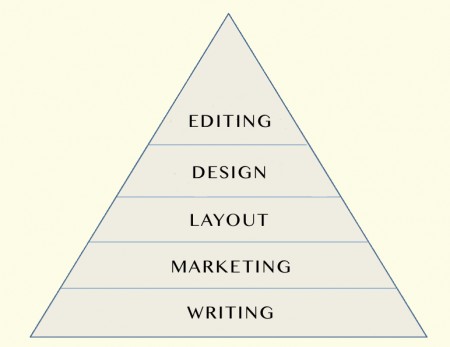The Outside Eye Hierarchy of Book-Publishing D.I.Y.
You’ve heard of Maslow’s Hierarchy of Needs? This is The Outside Eye Hierarchy of Book-Publishing D.I.Y. After talking to several of my indie author clients, I have cultivated a pretty good sense of what works and what doesn’t when it comes to doing it yourself. Depending on your time and budget, this third and final post in this series will help you decide what to do yourself and what to pay a pro to do for you.
Big caveat, though: like I mentioned in Part Two of this series, you can only D.I.Y. what you are actually good at. If self-promotion is not your thing and you have an allergic reaction to social media, you’re probably not going to be good at handling your own book marketing. I’ve worked with several clients who hated self-promotion but tried to cut corners by doing it themselves. Their books didn’t really sell until they finally gave in and hired a publicist well-versed in promoting self-published works.
At the top of the Outside Eye Hierarchy of Book-Publishing D.I.Y. are the things that don’t make much sense to do yourself. As we go down the pyramid, each element is more and more D.I.Y.-friendly.
1 Editing
I am not a fan of cutting corners with editing. This shouldn’t surprise anyone; I’m an editor. But even besides the fact that it’s how I make my living, I’ve seen too many indie authors try to save money on the editing process and end up with books that, best case scenario, were full of typos and rambling thoughts. Worst case scenario? Your book won’t make sense. You need that outside eye (yes) to give you perspective on what’s working and what’s not, from the high-level idea all the way down to each line of your manuscript. A good editor makes your writing better. An outside proofer is indispensable.
“Mark Coker, founder of Smashwords, one of the largest distribution channels for e-books, wrote recently that ‘if you’re preparing a book launch and you have a couple thousand dollars burning a hole in your pocket that you want to spend on marketing, spend that money on professional editing instead.’” — PBS.com
That said, when I know a client is on a very tight budget, I will sometimes suggest that he or she hire me for the developmental and line edits, then hire another, cheaper freelancer for the final proofing. Sometimes, editors charge a lower hourly rate for proofing (I don’t), and it’s always a good idea to have extra eyeballs on the book, anyway.
I have also written several posts about how to save money on book editing by making sure your manuscript is in excellent shape before you hand it off:
10 Tips to Save You Money on a Book Editor
2 Design
If you have an eye for design and a flair for sketching or photography, you might be able to illustrate your own book, or even create a cover design illustration on your own. Like I mentioned in the first part of this series, photographs and art need to be high-res unless you are only planning to publish electronically (an ebook). Instagram photos are not high-res, and they won’t print sharply, but you can set your smartphone camera to save a high-res version of all photos you take.
Even if you’re not design-y enough to D.I.Y. your illustrations, you can still semi-D.I.Y. your design by outsourcing the project to a cheap resource like Fiver or 99 Designs. You’ll have to manage the process, but you’ll have access to cheap art. However, like with editing, you generally get what you pay for. If you have a very distinct vision and high standards for design, you’ll be better off just paying a good designer.
By the way, I know plenty of excellent designers with all different styles, if you ever need a contact. But unfortunately, none of them are “cheap.” Worth it, yes! But not cheap.
3 Layout
This is a place you might be able to D.I.Y., if you have the time and the technical chops (and the patience). Depending on where and how you are planning to publish, there are various layout apps and programs you can use. One of the most traditional and popular is InDesign, an Adobe product. Like all robust pieces of software, it has a learning curve, and you’ll still need a design eye, but it IS possible to handle your own layout.
4 Marketing
Spreading the word about your book is probably the most reasonable place for you to do it yourself and save some cash. These days, there are so many ways to promote a book online, and with all of these resources at your disposal, you’re set up to win. Things like:
- Social media: Facebook, Twitter, Instagram
- Your own website
- And blog
- Newsletters (Constant Contact, Mail Chimp, etc.)
- Guest blogging for other sites about your particular specialty
5 Writing
And that brings us all the way to the bottom of the pyramid. Most authors, of course, D.I.Y. the actual writing process. If you’re writing a book, outsourcing the writing might not be on your mind, but I’ve been a ghostwriter on many projects. If you have a great idea—and perhaps you’re a well-known name that would be great at selling that idea—ghostwriting might in fact be the way to go. But, it’s expensive, so it’s not the best place to D.I.Y.


Great article. My process looked more like an amoeba.